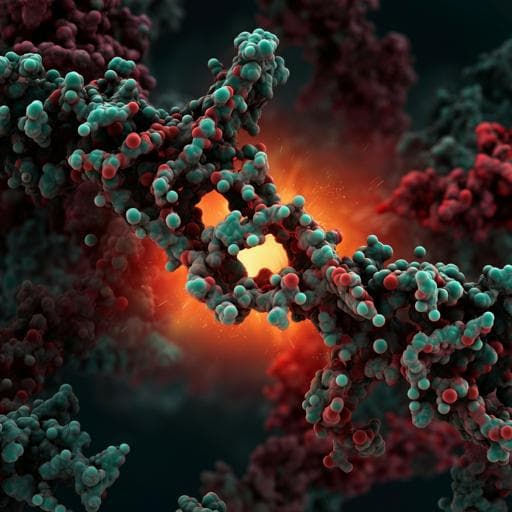
Biology
Design of a recombinant asparaginyl ligase for site-specific modification using efficient recognition and nucleophile motifs
J. Tang, M. Hao, et al.
This groundbreaking research by Jiabao Tang, Mengling Hao, Junxian Liu, Yaling Chen, Gulimire Wufuer, Jie Zhu, Xuejie Zhang, Tingquan Zheng, Mujin Fang, Shiyin Zhang, Tingdong Li, Shengxiang Ge, Jun Zhang, and Ningshao Xia introduces a high-performance asparaginyl ligase, OaAEP1-C247A-aa55-351, capable of efficient bioconjugation. With remarkable 70-fold enhanced activity, this innovation is set to revolutionize protein engineering and drug development across various pH levels.
~3 min • Beginner • English
Introduction
The study addresses limitations in existing enzymatic bioconjugation tools, particularly peptide asparaginyl ligases (PALs) such as butelase-1 and OaAEP1. While enzyme-catalyzed ligation offers advantages over chemical modification (mild conditions, specificity, preserved bioactivity), practical deployment has been hindered by difficult recombinant preparation, acid-activation steps that compromise activity, low yields, and unclear substrate requirements. Sortase A suffers from long recognition sequences and reversibility, whereas PALs offer shorter motifs but require activation and often have ambiguous substrate preferences. OaAEP1, related to butelase-1, can be expressed recombinantly, and the C247A mutation improves activity, yet preparation remains cumbersome and substrate selectivity needs clarification. The purpose of this study is to design a robust, high-yield recombinant ligase variant of OaAEP1 that eliminates harsh activation steps and to systematically define its substrate recognition and nucleophile preferences to enable efficient, site-specific protein and peptide ligation for applications in protein engineering and drug development.
Literature Review
Background covers enzyme-mediated ligation platforms including sortase A, PALs (butelase-1, OaAEP1, HeAEP3, OaAEP3-5, VYPAL1/2), transferases, inteins, and transpeptidases. Sortase A recognizes LPXTG but is limited by a long recognition motif and reversible reactions. PALs are produced as zymogens with cap domains removed by acid activation, enabling transpeptidation at Asn within short Asn-Xaa1-Xaa2 motifs near neutral pH, thereby addressing sortase’s long-motif limitation. Butelase-1, a highly efficient ligase from Clitoria ternatea, recognizes Asx-His-Val, with ligase activity exceeding hydrolysis, enabling rapid ligation and macrocyclization; however, recombinant expression has suffered from unsatisfactory yields and complex workflows. For OaAEP1, structural knowledge (resolved crystal structure) indicates a cap shielding the active site; Cys247 is implicated as a nucleophile channel, and a C247A mutant shows enhanced activity comparable to butelase-1. Despite these advances, practical application is limited by acid activation, unstable/poorly reproducible preparation, and unclear substrate and nucleophile profiles. These prior findings motivate engineering of a recombinant OaAEP1 variant that is active without acid activation and mapping of its sequence preferences.
Methodology
- Rational design and truncation: Based on OaAEP1 structure indicating an essential 271-aa core domain shielded by a cap, four truncations of OaAEP1-C247A were constructed to remove non-essential regions and avoid cap-mediated inactivity: aa24-351, aa55-351, aa24-325, aa55-325. Coding sequences were cloned into pET32a to express N-terminal TrxA-tagged, C-terminal His-tagged fusion proteins in E. coli BL21(DE3). Proteins were purified by cobalt IMAC, eluted with imidazole gradients, and analyzed via SDS-PAGE.
- Activity assay and specificity: A model substrate Pep133-NGL (pp65 aa133–147 with C-terminal Asn-Gly-Leu) and a GL- (biotin) nucleophile peptide were used. Ligation reactions (various buffers/pH at 37 °C, 30 min) were quantified by ELISA using anti-Pep133 antibody and HRP-streptavidin detection. Control peptides lacking NGL (Pep133, Pep445) assessed specificity.
- Integrity check: Purified OaAEP1-C247A-aa55-351 was analyzed by in-gel tryptic digestion and LC-MS/MS to verify sequence and assess potential auto-cleavage.
- Buffer optimization: pH scanning from 4.0 to 9.6 in acetate, phosphate, and Tris buffers evaluated pH dependence. Metal ion effects were tested by adding 100 μM CaCl2, MgCl2, KCl, FeSO4, MnCl2, ZnSO4, or FeCl3. Oxidation-reduction additives (H2O2, β-mercaptoethanol) were also examined. Fe3+ concentration was optimized, identifying 1 mM as optimal.
- Substrate and nucleophile profiling: Systematic substitutions at positions P1–P1′–P2′ (substrate C-terminus) and P1″–P2″ (nucleophile N-terminus) using representative amino acids (Ala, Gln, Phe, Asp, Lys) probed sequence tolerance. Additional substitutions explored variants around P1′ Ala (Val, Leu, Pro) and P1″ Lys (His, Arg) and pairing combinations to identify optimal partners. Requirement of free N-terminus at P1″ was assessed.
- Kinetics by FRET: FAM-labeled substrates Pep133-NXL (X=Ala or Gly) and Dabcyl-labeled nucleophiles XL (X=Arg or Gly) enabled real-time monitoring. Reactions (20 mM phosphate, pH 7.0, 37 °C, 2 min; substrate:nucleophile 1:3; 10–40 nM enzyme; with or without 1 mM Fe3+) were recorded at 465/510 nm. Initial rates from first 5 s were fit to Michaelis–Menten to derive kcat and Km.
- Ligation yield visualization: A 50-aa peptide C50-NAL and an RL-(biotin) polyXXK peptide were ligated (with Fe3+) and analyzed by SDS-PAGE to estimate conversion.
- Protein labeling: A properly folded recombinant truncated SARS-CoV-2 nucleocapsid protein (aa1–258) bearing C-terminal NAL (rtNP-NAL) was produced (pET-28a, BL21(DE3), cation exchange purification). Ligation with RL-(biotin) nucleophile was evaluated by ELISA using anti-NP antibody 17H11.
Key Findings
- Construct selection: All four truncations of OaAEP1-C247A showed ligase activity toward Pep133-NGL and GL nucleophile; OaAEP1-C247A-aa55-351 exhibited the highest activity and was pursued further. LC-MS/MS confirmed no unintended auto-cleavage and sequence matched design.
- pH profile: OaAEP1-C247A-aa55-351 is active from pH 4.0 to 8.0 with maximal ligation near pH 7.0–7.2; activity decreases at more acidic or basic conditions but remains detectable at pH 4.0 and 8.0.
- Metal ion effects: Ca2+, Mg2+, and K+ had no significant effect, whereas Fe2+, Mn2+, Zn2+, and especially Fe3+ enhanced ligation. Optimal Fe3+ concentration was 1 mM. Oxidants/reductants (H2O2, β-mercaptoethanol) impaired activity.
- Substrate recognition: P1 Asn is essential; substitutions at P1 abolished ligation. P1′ and P2′ tolerate substitutions with varying efficiency. Replacing P1′ Gly with Ala or Lys increased ligation, with P1′ Ala best overall; P1′ Gln/Phe and P2′ Ala/Phe were tolerated but less efficient.
- Nucleophile preferences: P2″ is stringent; only substitution of P2″ Leu with Phe retained nucleophilic competence among tested residues. P1″ is more flexible; Lys and Phe outperformed Gly, with Lys highest. Free N-terminus at P1″ is required. Pairing optimization identified Asn-Ala-Leu (NAL) as the best recognition motif with Arg-Leu (RL) as the best nucleophile pair.
- Kinetics: With NAL substrate and RL nucleophile in 1 mM Fe3+, OaAEP1-C247A-aa55-351 achieved kcat = 11.6 s−1, Km = 4.9 μM, kcat/Km = 2,376,384 M−1 s−1. Using the prior NGL-GL pair, values were kcat = 0.922 s−1, Km = 9.2 μM, kcat/Km = 100,647 M−1 s−1. Thus, NAL-RL improved catalytic efficiency ~24-fold over NGL-GL for this enzyme. Relative to previously reported ultrafast AEP(Cys247Ala) (kcat/Km ≈ 34,209 M−1 s−1) the new system is ~70-fold higher, and it is ~2-fold higher than the fastest reported butelase-1 condition (Asn-His-Val/Gly-Ile; kcat/Km ≈ 1,314,000 M−1 s−1).
- Yield and application: >90% conversion of a 50-aa peptide (C50-NAL) with an RL-(biotin) polyXXK peptide under Fe3+-containing conditions. Successful site-specific labeling of a folded recombinant SARS-CoV-2 nucleocapsid protein (rtNP-NAL) using RL-(biotin) peptide detected by ELISA, demonstrating applicability to protein substrates.
- Practical advancement: The engineered truncation (aa55–351) enables one-step expression and purification, avoiding acidic auto-activation and associated activity loss while providing robust activity across conditions.
Discussion
The engineered OaAEP1-C247A-aa55-351 addresses key barriers in PAL application by eliminating acid-activation and simplifying recombinant production while maintaining and enhancing catalytic performance. Structure-guided truncation to remove inhibitory regions but retain the catalytic core yielded a robust ligase that can be produced in high purity and activity from E. coli using a single purification step. Systematic mapping of sequence preferences clarified substrate and nucleophile requirements: strict dependence on P1 Asn was confirmed, while P1′ and P2′ positions showed exploitable flexibility that enabled optimization to the NAL motif. On the nucleophile side, enforcing a free N-terminus and selecting RL improved nucleophilicity and product formation. These sequence optimizations, combined with Fe3+ supplementation (optimal at 1 mM), substantially increased reaction rates and yields. The broadened pH tolerance around neutrality, the strong Fe3+-dependent enhancement, and the high kcat/Km (exceeding even the fastest reported butelase-1 condition) indicate the enzyme’s suitability for diverse in vitro bioconjugation tasks. Demonstrations with a 50-mer peptide and a folded viral nucleocapsid protein show the method’s practicality for site-specific labeling and conjugation in protein engineering and potential therapeutic development.
Conclusion
Using structural insights, the authors designed a recombinant OaAEP1 variant (C247A-aa55-351) that is active without acid activation and can be expressed and purified in a single step. They defined efficient recognition (Asn-Ala-Leu) and nucleophile (Arg-Leu) motifs and identified Fe3+ as a potent enhancer (optimal at 1 mM), yielding greatly improved kinetics and high product yields (>90% in a peptide model). The enzyme outperforms previously reported OaAEP1 variants and even surpasses the fastest butelase-1 in catalytic efficiency by approximately twofold under the optimized motif and Fe3+ conditions. These advances position OaAEP1-C247A-aa55-351 as a versatile tool for site-specific protein conjugation, polymerization, labeling, cyclization, and potentially for producing bispecifics or cyclic therapeutics. Future work may focus on mechanistic understanding of metal ion effects, expanding substrate scope, and applying the ligase in complex biological or in planta systems.
Limitations
The mechanism by which Fe3+ and other metal ions enhance ligase activity remains unresolved and warrants further study. The strict requirement for P1 Asn limits substitutions at this position. Most evaluations were conducted in vitro using model peptides and a single recombinant protein substrate; broader substrate scope and in vivo applicability were not assessed here.
Related Publications
Explore these studies to deepen your understanding of the subject.







